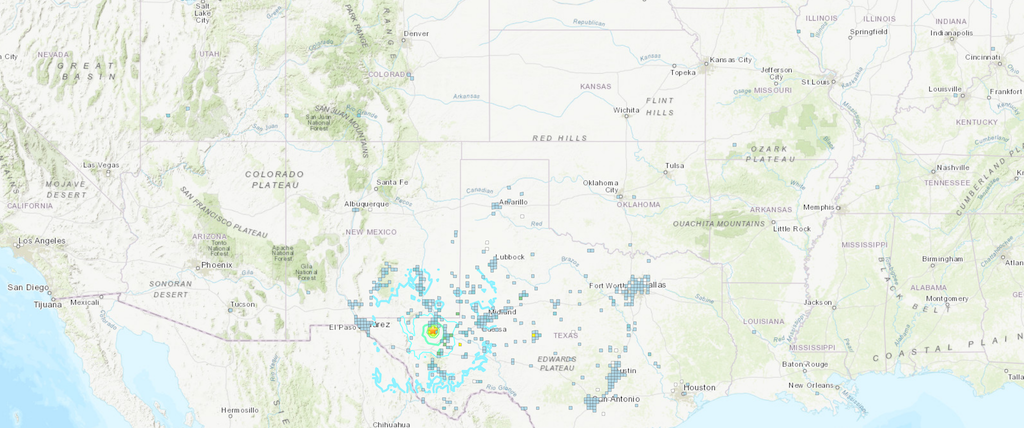
M 5.4 – 38 km WSW of Mentone, Texas
- 2022-11-16 21:32:44 (UTC)
- 31.637°N 103.999°W
- 6.9 km depth
Responses vs Time Plot (2,163 responses within 24 hours):

Some areas reported moderate to strong shaking with light damages.

As of Nov 17, 2022, over 2000 felt reports have been submitted, including some as far away as near Cininnati, Ohio:

5.4 magnitude earthquake hits West Texas, with reports of shaking all the way in Austin by Andy Jechow, Nov 16, 2022, KUT 90.5
An unusually large earthquake — for Texas — struck western parts of the state around 3:30 p.m. Wednesday. Staff at Texas Public Radio reported light shaking in San Antonio, and the U.S. Geological Survey said it has received reports of shaking in Austin.
The magnitude 5.4 quake appears to be one of the largest in Texas history, according to Jonathan Tytell, a geophysicist with the USGS. “This was a big event,” Tytell said.
The largest known earthquake to ever hit the state was a 6.0 magnitude quake in the town of Valentine, near Marfa, in 1931.
The epicenter of Wednesday’s earthquake was not far from the New Mexico border — about 35 miles northwest of the town of Pecos. The epicenter was close to the same area where a 5.0 earthquake hit in March 2020, Tytell said.
He said the earthquake was likely caused by oil and gas industry activity in the area.
Marfa Public Radio’s Travis Bubenik said he noticed his monitor shaking around 3:30. He noted this part of the West Texas oilfield has a history of earthquakes, “but this one is an unusually big one!”
KUT’s Mose Buchele reported in 2019 that earthquake activity in the state has “skyrocketed” in recent years because of increased oil and gas activity.
Did you feel the earthquake? The USGS asks that you fill out this online survey to let it know. As of around 5:15 p.m. Wednesday, 1,040 people had submitted reports.
Frac quake enabler Texas Railroad Commission (as evil as Alberta’s AER) had this to say:
Railroad Commission Sends Inspectors to Reeves County Following 5.4 Magnitude Earthquake, Agency to Take Any Action as Needed for Disposal Wells in Area Press Release by RRC, November 17, 2022
AUSTIN – The Railroad Commission deployed inspectors to Reeves County in response to a 5.4 magnitude earthquake near the border with Culberson County.
The agency is monitoring seismic data from the United States Geological Survey, the TexNET Seismic Monitoring Program and private operator monitoring stations and will take any actions necessary to protect public safety and the environment.![]() Pffft. I highly doubt the Texas energy regulator will do anything but protect the companies doing the drilling, injecting, frac’ing, quaking and shaking.
Pffft. I highly doubt the Texas energy regulator will do anything but protect the companies doing the drilling, injecting, frac’ing, quaking and shaking.![]()
RRC inspectors are examining disposal activity at injection wells in the area, and staff is also reviewing permit requirements and operators’ seismic response plans in the Northern Culberson-Reeves Seismic Response Area (SRA).
The SRA was created to reduce the intensity and frequency of earthquakes in the area and includes an Operator Led Response Plan (OLRP) with the objective “to reduce the occurrence of high-magnitude seismicity such that recurrence of 3.5 magnitude events is decreasing by December 31st, 2023.”![]() The “Plan” ain’t working, is it?
The “Plan” ain’t working, is it?![]()
Based on the reviews and meetings with operators, action will be taken on steps outlined in the OLRP. Actions outlined in the plan include, but are not limited to, expanding SRA boundaries and further reducing injection volumes.
The OLRP requires all deep disposal wells within a 9 km boundary in the SRA to shut-in for 24 months if a magnitude 4.5 or greater earthquake occurs within the boundary. There are no active deep disposal wells within the 9 km boundary. Reduction of injection volume from shallow disposal wells has occurred based on the schedule contained in the OLRP.
The potential lag time between changes in injection rates and changes in seismicity varies; historical activity indicates a potential lag time of 12-18 months.
RRC staff will continue its work and oversight toward reducing earthquakes in that region to keep residents and the environment safe.
